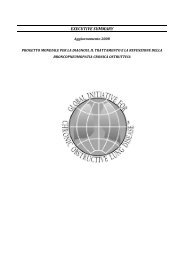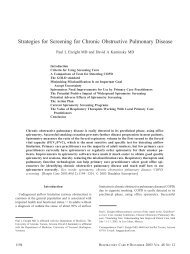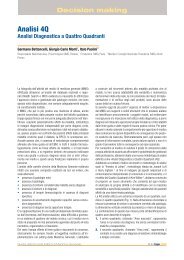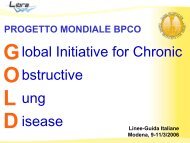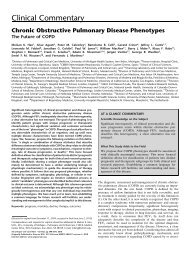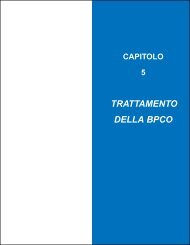Efficacy and safety of NVA237 versus placebo and ... - GOLD
Efficacy and safety of NVA237 versus placebo and ... - GOLD
Efficacy and safety of NVA237 versus placebo and ... - GOLD
You also want an ePaper? Increase the reach of your titles
YUMPU automatically turns print PDFs into web optimized ePapers that Google loves.
E. KERWIN ET AL. COPD<br />
<strong>versus</strong> <strong>placebo</strong>. <strong>NVA237</strong> was well tolerated <strong>and</strong> had an acceptable<br />
<strong>safety</strong> pr<strong>of</strong>ile, with a low incidence <strong>of</strong> typical anticholinergic<br />
adverse effects [8].<br />
Tiotropium, established as a safe <strong>and</strong> effective bronchodilator,<br />
is the only licensed LAMA available currently for COPD<br />
patients <strong>and</strong> is widely used worldwide. The objective <strong>of</strong> the<br />
phase III GLOW2 study was to evaluate the efficacy <strong>and</strong> <strong>safety</strong><br />
<strong>of</strong> <strong>NVA237</strong> 50 mg q.d. in patients with moderate-to-severe COPD<br />
compared with <strong>placebo</strong> <strong>and</strong> with tiotropium (as a reference<br />
comparator) over a longer treatment period <strong>of</strong> 52 weeks.<br />
METHODS<br />
More details are provided in the online supplement.<br />
Patients<br />
Males <strong>and</strong> females o40 yrs <strong>of</strong> age, with a smoking history <strong>of</strong><br />
o10 pack-yrs, a diagnosis <strong>of</strong> moderate-to-severe stable COPD<br />
(as defined in the 2008 Global Initiative for Chronic Obstructive<br />
Lung Disease (<strong>GOLD</strong>) guidelines) [9], post-bronchodilator FEV1<br />
o30% <strong>and</strong> ,80% <strong>of</strong> the predicted normal, <strong>and</strong> post-bronchodilator<br />
FEV1/forced vital capacity (FVC) ,0.70 were enrolled.<br />
Exclusion criteria included lower respiratory tract infection in<br />
the 6 weeks prior to screening; concomitant pulmonary disease<br />
(such as pulmonary tuberculosis or clinically significant bronchiectasis);<br />
history <strong>of</strong> asthma, malignancy <strong>of</strong> any organ system/<br />
long QT syndrome or QTc .450 ms (males) or .470 (females)<br />
at screening, symptomatic prostatic hyperplasia, bladder-neck<br />
obstruction, moderate/severe renal impairment, urinary retention,<br />
narrow-angle glaucoma, a known history <strong>of</strong> a 1 -antitrypsin<br />
deficiency; participation in the active phase <strong>of</strong> a supervised<br />
pulmonary rehabilitation programme; <strong>and</strong> contraindications for<br />
tiotropium or ipratropium or history <strong>of</strong> adverse reactions to<br />
inhaled anticholinergics.<br />
Study design <strong>and</strong> treatment<br />
This was a multicentre, double-blind, <strong>placebo</strong>-controlled with<br />
open-label tiotropium arm, parallel group study. Patients were<br />
r<strong>and</strong>omised to receive <strong>NVA237</strong> 50 mg q.d. or <strong>placebo</strong> (both<br />
delivered via a low-resistance single-dose dry-powder inhaler<br />
(the Breezhaler1 device; Novartis, Basel, Switzerl<strong>and</strong>); 50 mg<br />
refers to the quantity <strong>of</strong> the glycopyrronium moiety present in<br />
the capsule, which corresponds to a delivered dose <strong>of</strong> 44 mg),<br />
or open-label tiotropium 18 mg (delivered via the H<strong>and</strong>iHaler1<br />
device; Boehringer Ingelheim, Ingelheim, Germany) in the<br />
morning between 08:00 <strong>and</strong> 11:00 h, in a ratio <strong>of</strong> 2:1:1 for a<br />
period <strong>of</strong> 52 weeks, following a washout period (<strong>of</strong> up to<br />
7 days) <strong>and</strong> a 14-day run-in period (fig. 1).<br />
Patients were to discontinue taking long-acting bronchodilator<br />
therapy before starting the run-in period (for at least 7 days for<br />
LAMAs or 48 h for long-acting b 2 -agonists (LABAs) or LABA/<br />
inhaled corticosteroid (ICS) combinations). Patients using<br />
LABA/ICS combinations were switched to an equivalent dose<br />
<strong>of</strong> ICS as monotherapy plus salbutamol/albuterol as rescue<br />
medication for at least 48 h prior to screening. The ICS doses<br />
had to remain stable during the screening period; patients who<br />
failed screening for this reason could be re-screened if the ICS<br />
dose had been stable for 1 month. Patients were expected to<br />
remain on the same dose <strong>of</strong> ICS throughout the study.<br />
Visit 1<br />
Screening Run-in Placebo<br />
Day -21 to<br />
Day -14<br />
Visit 2<br />
Day -14 to<br />
Day -1<br />
R<strong>and</strong>omisation<br />
FIGURE 1. GLOW2 study design.<br />
52-week double-blind treatment period<br />
<strong>NVA237</strong> 50 µg<br />
Tiotropium 18 µg open-label<br />
Visits:<br />
Weeks 1, 3, 5, 9, 12, 16, 20, 26, 34, 42, 50 <strong>and</strong> 52<br />
In addition to the study treatment, concomitant medications<br />
(inhaled or intranasal corticosteroids <strong>and</strong> H1 antagonists) were<br />
permitted in patients who had been stabilised on a recommended<br />
<strong>and</strong> constant dose prior to study entry. Patients were<br />
provided with a salbutamol/albuterol inhaler to be used as<br />
rescue medication during the study.<br />
<strong>Efficacy</strong> assessments<br />
<strong>Efficacy</strong> was assessed in the full analysis set (FAS) which<br />
included all r<strong>and</strong>omised patients who received at least one<br />
dose <strong>of</strong> the study drug; patients in the FAS were analysed<br />
according to the treatment to which they were r<strong>and</strong>omised.<br />
The primary efficacy variable was trough FEV1 (defined as the<br />
mean <strong>of</strong> the 23 h 15 min <strong>and</strong> the 23 h 45 min post-dose values)<br />
following 12 weeks <strong>of</strong> treatment. Key secondary variables were<br />
dyspnoea measured using the TDI at week 26 <strong>and</strong> health status<br />
according to the total score on SGRQ at week 52. Important<br />
secondary variables were time to first moderate or severe COPD<br />
exacerbation <strong>and</strong> mean daily rescue medication use over<br />
52 weeks. Additional secondary variables included trough<br />
FEV1, trough FVC <strong>and</strong> inspiratory capacity at the end <strong>of</strong> day 1<br />
<strong>and</strong> at weeks 26 <strong>and</strong> 52, serial spirometry in a subset <strong>of</strong> patients<br />
(in study sites which had the facilities <strong>and</strong> personnel for making<br />
these measurements) on day 1 <strong>and</strong> weeks 12 <strong>and</strong> 52, <strong>and</strong> the rate<br />
<strong>of</strong> COPD exacerbations in the 52-week treatment period.<br />
Comparison <strong>of</strong> open-label tiotropium 18 mg to <strong>placebo</strong> <strong>and</strong><br />
<strong>NVA237</strong> in terms <strong>of</strong> all the end-points was also an additional<br />
variable; the study was not powered to show statistical<br />
superiority <strong>of</strong> <strong>NVA237</strong> <strong>versus</strong> tiotropium.<br />
Safety assessments<br />
The <strong>safety</strong> population included all patients who received at<br />
least one dose <strong>of</strong> the study treatment; patients were analysed<br />
according to the treatment they received. Safety was assessed by<br />
recording treatment-emergent adverse events <strong>and</strong> monitoring<br />
vital signs (pulse rate <strong>and</strong> systolic <strong>and</strong> diastolic blood pressure),<br />
<strong>and</strong> laboratory analyses (haematology, clinical chemistry <strong>and</strong><br />
urinalysis).<br />
Statistics<br />
The primary efficacy variable (trough FEV1 at week 12) was<br />
analysed using a mixed model, with treatment as a fixed effect<br />
<strong>and</strong> baseline FEV1 <strong>and</strong> FEV1 reversibility (in response to 80 mg<br />
ipratopium bromide), <strong>and</strong> baseline ICS use (yes/no) acting as<br />
c<br />
EUROPEAN RESPIRATORY JOURNAL VOLUME 40 NUMBER 5 1107



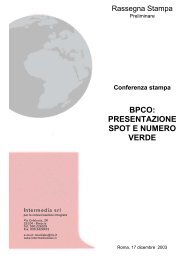
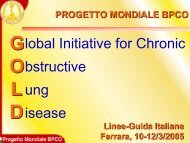
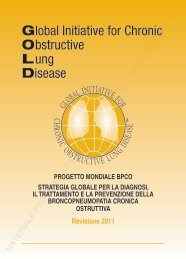
![Di Bari [NO].pdf - GOLD](https://img.yumpu.com/21544924/1/190x143/di-bari-nopdf-gold.jpg?quality=85)

